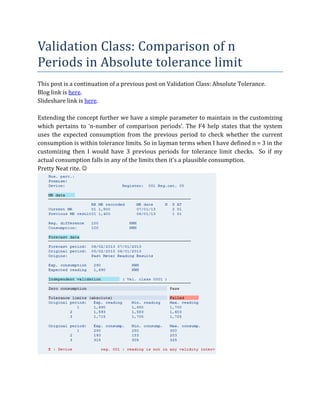
SAP ISU Validation Class : Comparison of n periods
- 1. Validation Class: Comparison of n Periods in Absolute tolerance limit This post is a continuation of a previous post on Validation Class: Absolute Tolerance. Blog link is here. Slideshare link is here. Extending the concept further we have a simple parameter to maintain in the customizing which pertains to ‘n-number of comparison periods’. The F4 help states that the system uses the expected consumption from the previous period to check whether the current consumption is within tolerance limits. So in layman terms when I have defined n = 3 in the customizing then I would have 3 previous periods for tolerance limit checks. So if my actual consumption falls in any of the limits then it’s a plausible consumption. Pretty Neat rite. ☺
- 2. The above screen shot shows us the 3 periods of the Tolerance limits (absolute). As my current meter reading (1500 units) doesn’t fall within any of the given 3 period ranges it has failed the validation. The validation check is done by the system after it has executed the estimation run. So even if n is maintained as 0 or 1, it will always have a single entry which would the ‘original period’. If n > 1 then system would go back into the consumption history to fetch more entries. The Base period category matters which is maintained in the Installation. Here it’s maintained as ‘previous period’. The meter reading unit maintained in the Installation matters as it gives us the period length for n. Here the period length is 1 month. Here is the consumption pattern till date and we are estimating the meter reading for 1st July 2013. So accordingly the system will propose the following consumption. (300 units / 31 days) * 30 days = 290 units (truncated). The calculation for base period check is not shown here. Consumption for the period 1st May 2013 to 1st June 2013 is 300 units Number of days in the forecast period (1st June 2013 to 1st July 2013) is 30 days Number of days in the original period (1st May 2013 to 1st June 2013) is 31 days. The absolute tolerance limits are maintained as +/- 10 units. So writing this down in Tolerance limit ranges Expected Consumption 290 Minimum Consumption 280 Maximum Consumption 300 units units units Expected Meter Reading Minimum Meter Reading Maximum Meter Reading 1690 units (1400+290) 1680 units 1700 units
- 3. This also defines the first comparison period. For the second comparison period which would come after the first period i.e. 2nd April 2013 to 1st May 2013 Consumption of the period (1st April 2013 to 1st May 2013) is 190 units for 31 days Adding previous period per day 9.677 (300/31), so per day it comes to 199.677/31= 6.441 The number of days in first period is 30 days. So the consumption for the first period is 6.441 * 30 = 193.236 which is truncated to 193 units. So writing this down in Tolerance limit ranges Expected Consumption 193 Minimum Consumption 183 Maximum Consumption 203 units units units Expected Meter Reading Minimum Meter Reading Maximum Meter Reading 1593 units (1400+193) 1583 units 1603 units This defines the second comparison period. Estimated Consumption for the third comparison period (2nd March 2013 to 1st April 2013) Consumption of the period (1st March 2013 to 1st April 2013) is 330 units for 31 days Adding previous period per day 6.333 (190/31), so per day it comes to 336.333/32 = 10.510 The number of days in first period is 30 days. So the consumption for the first period is 10.510 * 30 = 315.313 which is truncated to 315 units. So writing this down in Tolerance limit ranges Expected Consumption 315 Minimum Consumption 305 Maximum Consumption 325 units units units Expected Meter Reading Minimum Meter Reading Maximum Meter Reading 1715 units (1400+315) 1705 units 1725 units This defines the third comparison period. So combining all if my meter reading is within 1583 units to 1725 units then it’s a plausible reading. So the definition of n would depend on the Business requirements on how many periods they are ready to compare. That’s it. Thanks ☺
